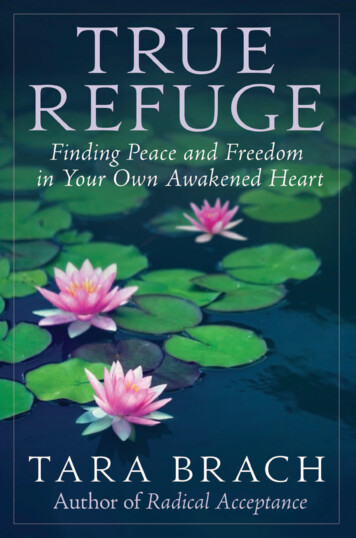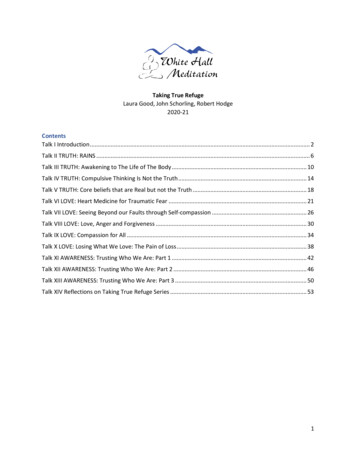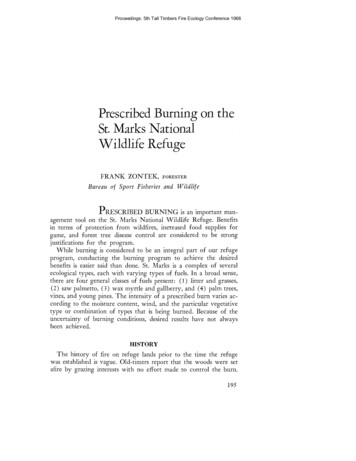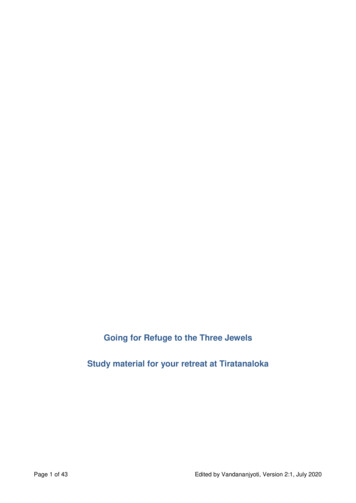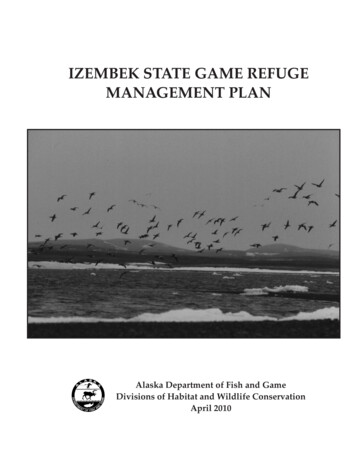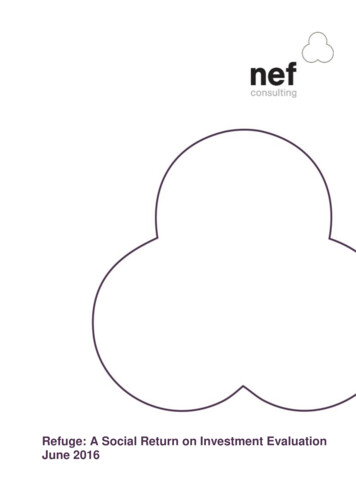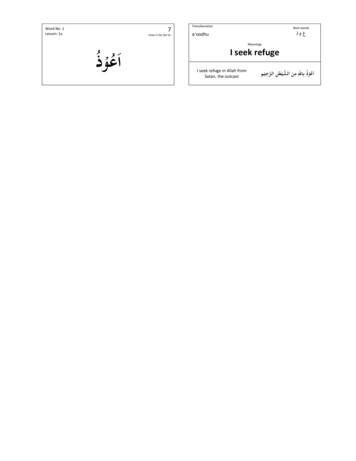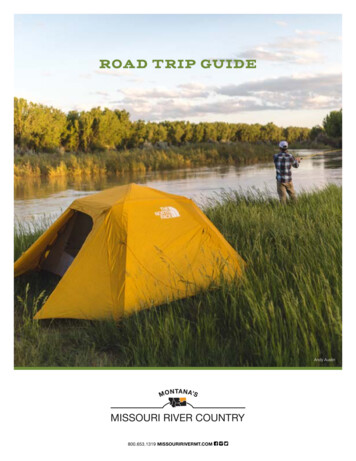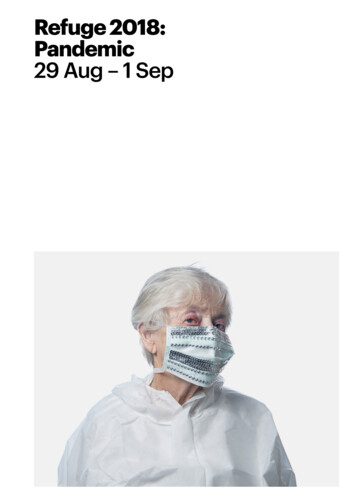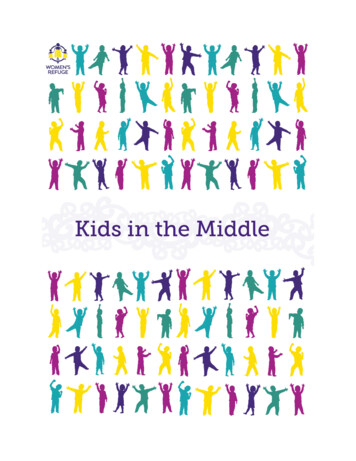
Transcription
AuthorsCleo Arathoon, Research and Development AdvisorDr Natalie Thorburn, Principal Policy AdvisorDr Ang Jury, Chief ExecutiveNational Collective of Independent Women’s RefugesThe National Collective of Independent Women’s Refuges (NCIWR) is a central part of the solution to NewZealand’s problem of family violence – both in the context of providing an immediate crisis and longer-termsupport. In 2019/20, our network of 40 affiliated refuges received 42,510 crisis calls and provided 61,763nights of secure accommodation within our safehouses, with direct assistance provided to 38,521 womenand children. A large and growing percentage of our client base consists of children and young peopleunder the age of 17 years, with 52% of these children under the age of 10 years.The office of the NCIWR is at: Ground floor, 275 Cuba Street, Te AroPostal address: PO Box 27-078, Marion Square, Wellington 6141 Phone: 04 802 5078Copyright 2021 National Collective of Independent Women’s Refuges.1
AcknowledgementsOur first and biggest thanks goes to the tamariki who took part, and to their mothers whosupported and enabled their participation.Our next thanks is to The Warehouse, who are a valued partner of Women’s Refuge. Thisresearch into children’s experiences of support after family violence would not have been possiblewithout your commitment both to this project and to Refuge.We would also like to thank Sheree Ryder for the koha of her kōrero. Sheree generouslyincorporated her knowledge of Te Ao Māori to support the implications chapter, providing aperspective that would not have otherwise been possible.Finally, Kids in the Middle was made possible by the generosity and willingness of our memberRefuges and advocates. Even though protecting participants’ privacy means we cannot refer toyou by name, you know who you are. Thank you for believing in the project, for extending ourinvitation to take part to the women and children you work with, and for generously offering yourtime and resources to ensuring the safety of the participants and their whānau.2
DedicationKids in the Middle is dedicated to all the amazing kids and Mums who have ever known, and whowill ever know Refuge. Specifically, it is dedicated to the 19 incredible children (aged from 5 to13) who taught us so much, and to their nine awesome Mums who allowed us to speak with theirchildren. To every one of you - thank you! We am using your ‘assistant researcher’ names in thisreport just like we talked about.We talked to you because we really wanted to know what it is like for young people to come intoRefuge for the first time. It has been a long, long time since we were kids, so we really neededyou to tell us. We were keen to hear how it felt, what you remembered most, and what ideas youhad to make it better.You offered your thoughts and insights, and that enabled this whole project to happen. By tellingyour stories, you gave us a great gift. We listened to your helpful and brave suggestions, yourinsistence on improvements, and your expert voices. You spoke heaps about your journeys withus at Women’s Refuge. That is why this report begins with your voice. Without you, this reportcould not exist - you are the essential ingredient.Our gratitude for your koha, time, energy, laughter, silliness, and seriousness is reflected in howwe set out this report. We start by explaining how we got to interview such amazing kids, and weexplain how you told us you wanted to take part. Next, we look at what happened in our interviews.We jump right into what you told us because that is the most interesting part. After that, we talkabout how we listened to you, and how we thought about your stories. You will see that at thestart of every chapter, we have written a bit just for you.We tried to keep your words pure and do justice to them. You can tell us if we have got any of itwrong! We decided to write about your stories first and keep all of the other research bits to thevery end. If adults are looking for the literature overview and methods (kids, these are the longwordy research bits!) they can find them as appendices (Appendix A, Appendix B).Kauri (8), you clearly showed us you are best placed to assist us with our mission to make ourservices better for you.3
InterviewerKauriInterviewerKauriDo you know how Refuge helped Mum?No.That’s okay, no worries.But I know how Refuge helped me.Charlotte (9), we know that you were able to freely tell us what you thought, and your quote is agreat way to show that. It sets the scene, showing your selflessness and care for others who havehad similar experiences to you. It shows your unabashed dedication to the process and yourdetermination to highlight the gaps so we can be better!InterviewerCharlotteIs there anything about this place [Refuge], like if you had a milliondollars, that you would want to change?I would give it all to Women’s Refuge so that they could helppeople who needed things and they could buy them and helpthem make this place better. I’m not saying that it’s bad, I’msaying it is really good, they could make it better. There isalways room for improvement.Finally, Ihaka (9), your advice for other children is perfect. We could never say it better. Everyword you spoke was a gift, so thank you.“Be good, be safe, care for each other, be good”“Be the best kid you can be!”4
Executive SummaryHearing tamariki speak about their experiences with Women’s Refuge has enabled us togenuinely view children as an individually deserving client group with an equivalent, but specificset of needs. Kids in the Middle analysed how support is currently offered to tamariki and identifiedwhat integrated support must look like for tamariki who access our services in the future. Many ofthe preconceived ideas that were held about effective practice with children were transmuted aschildren exposed what true partnership looks like and feels like to them. Tamariki imparted theirexpert knowledge and provided the opportunity for adults to gain a real understanding of whatchildren require and what support they value as they navigate their journeys in the aftermath ofviolence.ConsentForegrounding the findings is our attention to the dynamic practise of consent with children. Fortheir participation to be meaningful to them, rather than solely to us, we needed to carefullyconstruct the foundations from which children could build and assert their confidence, preference,and voice. Using the temporal separation of ‘before’, ‘during’, and ‘after’ children’s participation,the ‘consent’ chapter explains our approach to positioning children as our partners and advisorsin this research. Children then affirmed this approach by exhibiting their fluid enactment of consentand demonstrating how their autonomy and confidence was supported by the research designand the relational setting of their interviews.BeforeBefore children arrive at Refuge for the first time, they are impacted by the violence perpetratedin their households and by the upheaval precipitating their contact with Refuge. The childrendescribed physical and emotional abuse directed toward their mothers and themselves, andreferred to tactics of coercion used by perpetrating parents that made them feel confused andhelpless. In contrast, children’s recollections of family functioning portrayed their mothers as safe,protective, and attentive, and as employing a range of strategies to ensure their children’swellbeing, and to resist the perpetrator’s violence and its impacts. Although each participant’sbackdrop of violence was uniquely experienced by them, their narratives shared common facetsand were associated with significant commonalities of emotional response. These emotionalresponses represent an important aspect of their introductions to Refuge, and the ways they5
perceive and build safety for themselves. In every participant’s account, the contexts leading upto their initial contact with Refuge clearly influenced their needs for and perceptions of support.During their interviews, children showed us how articulate they were when considering andexpressing emotion, their vulnerability when sharing challenges and difficulties, and how theyenacted their resilience when faced with daunting new prospects. These children have nowbenefited from child-targeted support that strengthened their self-awareness and emotionalliteracy. However, their characterisation of hypothetical other children and their recollections oftheir own entry and introduction to Refuge also offer critical insight into the preconditions thatmust be met for children to identify and express their emotional experiences. These emotionalexperiences are expressed differently than their mothers, but are equivalent in depth, significance,and uniqueness.Accordingly, child clients are far from passive passengers in their mothers’ journeys. Rather, theirrecollections of first accessing Refuge suggest that, if equipped with child-focused roadmaps,children are capable of proficiently navigating their own unique experiences. Throughout theirstories of ‘before’, children offered insights that highlight how Refuges may lend greater power tochildren arriving at the temporary destination of Refuge in the future.DuringIn the ‘during chapter’, we highlight how children’s articulation of thoughts and feelings may beregarded as subalternate to adults’ experiences if we are insufficiently attuned to how childrencommunicate personal experience and feeling. Honouring both the way children expressthemselves and how children understand their positioning just prior to their initial Refuge contactoffers dual benefits. First, it generates greater potential to identify the specific needs of children,and therefore more tailored support for them. Second, that understanding may have direct andongoing transferability into feedback loops that contribute to the continuous improvement forthose services in the future.Children clearly explained what brought them comfort and a sense of belonging, and how theseform the basis for coping and therefore offered them a sense of safety. Embedded in theinfrastructure of their everyday lives, children’s coping also signalled greater potential forpurposeful fostering of children’s negotiation of safety than what could be practicable within a tenweek children’s programme. In contrast to an individualist, skills-based approach, the intentionaldesign of a service responsive to the needs of children represents the scope to strengthen6
children’s structures of safety, including those that will remain with children after they exit Refuge.In sum, continuity of support for children corresponds to continuity of children’s coping.AfterChildren experienced Refuge with and alongside other children, and benefited from thesereciprocally supportive friendships. They identified significant gains that Refuge had offered them,and demonstrated their pride in their learning and their connection with others. However, just astheir transitions ‘to’ Refuge represented upheaval and anxiety about the future, so too did theirtransitions ‘from’ Refuge. Their exits and endings were marked by intensely felt grief and sadnessat the loss of their friendships and their roles at Refuge, by their continued worry about their ownand their family’s futures, and by apprehension about the sustainability of the safety they hadexperienced while at Refuge. Their worries were in part associated with limitations in how whānauwere brought into the work with children, such as the minimal facilitated involvement of theirmothers in their learning, and the under-explored characterisations of their perpetrating parents.The children each underlined the values that needed to underpin a service that is just for them,including the tailoring of support that can be sustained beyond their immediate involvement withRefuge, the continuous commitment to inviting, hearing, and utilising children’s feedback into whatworks for them, and a focus on the transferability of skills, safety, and learning beyond the Refugecontext.Importantly, children felt that sustainable support must involve the capacity for their connectionswith (and opportunities to contribute to) other children to be maintained after their safe house stayor programme participation ends. Finally, through their representations of the key characters intheir ‘after’ stories, they emphasised why support for children must be both family violenceinformed and child-centred.ContinuityIn the ‘continuity’ chapter, which concludes the research findings, nine-year-old Charlotte’sproposal is used to demonstrate children’s capacity to express views and give input, and toemphasise the shift in focus from equipping children with the right skills to ‘cope’ to equippingadults with the right skills to support children’s coping. We use this proposal both in its entiretyand with our interpretation added to demonstrate what children feel is integral to support that isdesigned for them.7
Eight-year-old Kauri showcases how influential positive Refuge experiences can be for childrenlong-term. The kindness that he saw, found his own truth in, and then practised in contexts beyondRefuge is testament to the potential for children to grow, thrive, and contribute to others whenthey feel confident, comfortable, and safe. Both children’s powerful stories show that above all,support designed for children must be predicated on how we hear them and think about them –before, during, and after their time at Refuge.8
Meet the kids9
PrefaceWhile Kids in the Middle is about children, ultimately it is for us, Women’s Refuge. The more weunderstand about children’s experiences, the more we can strengthen the ways we support them.However, our design of the Kids in the Middle data collection and analysis process was explicitlyfor children, not just about them. As Women’s Refuge’s policies reflect, children are taonga; theydeserve every protection, every opportunity, and every form of support and care that we can offer.Kids in the Middle aimed to explore how children understood their involvement with Refuge, howthey demonstrate ‘coping’ while they access our services, which aspects of the support that theyaccess are meaningful or useful to them, and how they feel this could be improved. However, thescope of what they gave us through their participation transcended these aims to build acomprehensive story of the entirety of their experiences at and beyond Refuge.Their narratives offered insight into children’s experiences that surpassed our every expectation,and these are represented in the five findings chapters that commence this report. As theunconventional placement of these findings suggests, the structure of Kids in the Middle differsfrom that of a typical research report. Like we emphasised in our dedication to the children, thisreport begins with the most important part: children’s stories.Elevating the voices of children and maintaining children’s safety were (and are) our overarchingpriorities. How we conceptualised children’s roles and our roles in this research were foremostinformed by these; children took up positions of Kids in the Middle ‘expert advisors’. We hope theway we set out this report does justice to their expert rviewerCharlotteInterviewerCharlotteInterviewerIf we wanted to work more with children what would we call a placelike this?‘People Refuge’.‘People Refuge’?Because we are all people.Who is invited to ‘People Refuge’?Everyone, no aliens.No aliens allowed?Or lizard people or chicken people.No lizard people for sure!10
Contents PageACKNOWLEDGEMENTS . 2DEDICATION . 3EXECUTIVE SUMMARY . 5Consent. 5Before . 5During . 6After . 7Continuity . 7PREFACE . 10CONTENTS PAGE . 11FINDINGS . 15CHAPTER ONE: CONSIDERING CONSENT . 17CONSENT – OVERVIEW . 18CONSENT – BEFORE . 19CONSENT – DURING . 24CONSENT – AFTER . 28CONCLUDING CONSENT . 29CHAPTER TWO: BEFORE REFUGE . 30OVERVIEW OF ‘BEFORE’ . 31BEFORE – SETTING . 32Introduction . 32Adults’ decision-making . 32Upheaval . 36Conclusion . 38BEFORE – SELF . 39Introduction . 39Risk and relief . 39Equivalence of emotion . 4111
Children’s communication of emotion . 43Drawing on relational experiences . 45Conclusion . 47BEFORE – OTHER . 49Introduction . 49Advocates . 49Conclusion . 53CONCLUDING THE ‘BEFORE’. 55CHAPTER THREE: DURING REFUGE . 56OVERVIEW OF ‘DURING’ . 57DURING – SETTING . 58Introduction . 58Emotional climate ‘during’ Refuge . 58Playing . 59Preoccupation with safety . 63Building comfort; building safety . 65Coping. 71Conclusion . 71DURING – SELF. 73Introduction . 73Positive regard for Refuge. 73Worry about the future . 74Ownership and identity . 75Information overload . 77Children’s perceptions of skills acquisition. 78Continuity of skills acquisition. 80Conclusion . 83DURING – OTHER . 85Introduction . 85Children. 85Mum . 89Conclusion . 90CONCLUDING THE ‘DURING’ . 9212
CHAPTER FOUR: AFTER REFUGE . 93OVERVIEW OF AFTER . 94AFTER – SETTING . 95Introduction . 95Adults’ decision-making . 95Conclusion . 97AFTER – SELF . 98Introduction . 98Equivalence of emotion and personal investment . 98Conclusion . 100AFTER – OTHER . 102Introduction . 102Children. 102Mums . 106Dads. 108Conclusion . 110CONCLUDING THE ‘AFTER’. 111CHAPTER FIVE: CONTINUITY . 112OVERVIEW . 113KAURI’S CYCLE OF FORMATIVE LEARNING . 114CHARLOTTE'S PROPOSAL. 117CONCLUSION . 123DISCUSSION . 124OVERVIEW . 125BEFORE – SETTING . 128BEFORE – SELF . 131BEFORE – OTHER . 132DURING – SETTING . 134DURING – SELF. 137DURING – OTHER . 140AFTER – SETTING . 143AFTER – SELF . 14613
AFTER – OTHER . 148CONCLUSION . 154VALUES AND IMPLICATIONS . 155VALUES. 156Te tapu o te tamaiti . 157Whanaungatanga . 158Koha mai, koha atu. 159Whakapapa. 160Te mana o te tamaiti . 160Glossary. 161IMPLICATIONS. 163APPENDICES . 168APPENDIX A – LITERATURE BACKDROP . 168APPENDIX B – METHOD .
transitions 'from' Refuge. Their exits and endings were marked by intensely felt grief and sadness at the loss of their friendships and their roles at Refuge, by their continued worry about their own and their family's futures, and by apprehension about the sustainability of the safety they had experienced while at Refuge.
